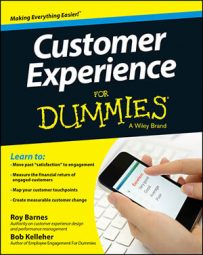Nobody’s perfect. But some customers come pretty darned close. These so-called “perfect customers” behave in ways that save your company money. For example, suppose you work for a utility company. In that case, your “perfect customer” might behave as follows:
He’d never contact the call center. For some companies, the cost of running a call center can run $12 to $15 per call! If your organization fields thousands or millions of calls a year, even a modest decrease in the number of customers calling in can save beaucoup bucks.
He’d use self-service options whenever possible. Self-service options enable customers to find information and solve problems without the help of a human — and therefore at no (or low) cost to the utility.
He’d set up his checking account for automatic withdrawals to pay his bill. No more late payments! This helps cash flow immeasurably.
He’d elect to receive bills electronically. Sending out thousands of bills each month via U.S. Mail can cost a pretty penny! Having customers switch to e-billing saves the sample utility company a ton of cash.
He’d use seasonal billing. This would allow for a predictable monthly bill throughout the year. If customers start their seasonal billing during a month when they don’t use much energy, they may pay more than normal for a couple of months until higher-usage months start. This can help the overall cash flow.
He’d allow the installation of load-balancing equipment at his home or business. This equipment allows the utility to “brown out” electrical needs during times of higher demand. In this way, the utility can serve more customers, more effectively, even at times of peak usage.
He’d welcome new technologies, like smart metering. In many cases, in order for a utility company to install new technologies at its customers’ homes and businesses, it needs permission from the customer. Getting permission means having a good relationship. And having a good relationship necessitates that a good experience has been previously provided!
He’d upgrade inefficient equipment. It sounds crazy, but many utilities don’t want their customers to use more energy. Perhaps those companies can’t or don’t want to build more capacity. These companies must prod their customers to save energy and be as efficient as possible.
If you could persuade more of your customers to exhibit even one of these “perfect” behaviors — for example, using e-billing rather than opting to receive a paper bill — the results could be significant! For example, suppose that only 16 percent of current customers use e-billing, while the current best-in-class for similar-sized utilities is 84 percent.
Suppose further that for each customer who uses e-billing, your company saves $11 per year. If your company were to move from 16 percent to 84 percent e-billing, it would save a whopping $3,470,000! Of course, immediately achieving best-in-class results is probably unrealistic.
Nonetheless, getting even halfway there would represent a significant cost savings. And if you were able to persuade customers to display all the aforementioned behaviors? Your organization might well save tens of millions of dollars, depending on its size!
So how do you change these behaviors? Simple. If you improve customer experience, then you will improve the quality and strength of your relationship with the customer. And if you do that, then you can begin to modify customer behavior in directions that make the company more money.
Oh, and one more thing: Research shows that customers who exhibit a greater number of “perfect” behaviors also tend to have significantly higher overall customer satisfaction scores. This makes sense at an intuitive level. After all, if you involve the customer in more things your organization does, her engagement scores will increase.
![[Credit: Illustration courtesy of Roy Barnes.]](https://www.dummies.com/wp-content/uploads/457187.image0.jpg)
Obviously, unless you work for a utility company, your “perfect customer” will display a different set of behaviors than the ones discussed in this section. To pinpoint what those behaviors are, gather a group of relatively senior people from a broad cross-section of your company and ask them this question:
If we could get our customers to behave in ways that would make our company more money (either because customers would be cheaper to serve or because they would spend more), what would we like them to do or not do?
Recently, this question was posed to senior employees at a telecommunications client and unearthed more than 45 different “perfect customer” behaviors. When the cost of each of these behaviors was then determined, the client discovered an additional $8 million in recoverable cost dollars. Needless to say, the CFO was very happy!
A sound customer-experience strategy yields positive benefits on both sides of the profit and loss statement. On the one side, engaged and happy customers are more likely to buy more and refer others to you, and are less likely to switch to a competitor. On the other hand, thoughtful experience design, done with the goal of modifying customer behaviors, can help you lower operational costs in customer-facing processes.

